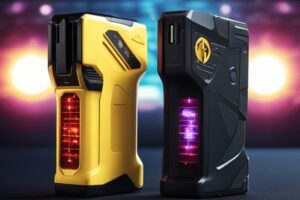How Many AMPS In A Taser?
Tasers operate differently than shock rays by sending electric pulses through clothing and air (nonconductors of electricity) before coming in contact with skin, according to Taser International.

Tasers utilize 50,000 volts of electricity to stimulate the nervous system and induce muscle contractions for temporary incapacitation, said Kehoe. They were an improvement over stun guns manufactured prior to 1999 that only targeted sensory nervous system receptors, she noted. Tasers produce “neuromuscular incapacitation,” in which victims experience pain while losing control over their muscles for up to five seconds before officers arrive and handcuff the individual.
Tasers can help police officers disarm individuals. Each shot discharges battery electrodes stored within a cylindrical magazine that fits between their hands. Each discharge then releases electrical pulses up to 50,000 volts and 26 amps that travel through embedded dart electrodes into human electro muscular systems “EMS -Electrical muscle stimulation”and inhibit motor reflexes.
Though its power seems extreme, Taser’s 50,000 volts only last for fraction of a second before draining and shutting off; amperage (current passing through target) is much lower.
Voltage Vs Amperage:
When purchasing a stun gun, seek models with both high voltage and low amperage outputs, like the Taser X26 used by police worldwide. Its combination makes it one of the most powerful stun weapons; even thick clothing won’t protect attackers against its powerful outputs.
Consider how often your Taser can be fired as this will have a direct effect on its durability and lifecycle. The Taser X26 provides up to 1200 shots per charge – comparable to standard police issue stun guns.
How Many Volts Are Deadly?
Taser gun pulses have not been reported as killing anyone, yet their shock of up to 50,000 volts has been shown to cause short-term cognitive impairment which may have long-term repercussions for those being shocked, which is why police should always inform suspects prior to firing their CED gun.
However, in situations in which suspects act recklessly or refuse to follow police orders, police have the right and responsibility to use Taser stun guns if necessary – provided sufficient warning has been given before initiating their use in each circumstance. It must always be proportionate and necessary.
How Many Amps Does a Police Taser Consume?
Tasers emit up to 50,000 volts through its electrodes when fired by police officers, yet amperage is what really causes damage by sending electricity coursing through your body.
Tazing involves firing two barbed probes embedded in their skin at approximately 55 meters per second – less than one-fifth the speed of an ordinary firearm bullet – until they hit flesh, where an electrical charge travels through their muscles to cause intense pain, muscle contractions and temporary paralysis. A typical Taser pulse lasts five seconds on average and causes intense discomfort as well as temporary paralysis in its target.
Shock may cause heart attacks in rare instances; however, such events are exceedingly rare; out of 1,100+ people Tased during one study, only 10-20% died from shock with most experiencing only minor injuries; far more often people die due to stress from police use of Taser devices on them.
Taser electrodes deliver high-frequency pulses that disrupt communication between brain and motor nerves, producing pain as a result and leading many victims to collapse unconscious to the floor after being hit.
Most news articles discuss taser voltage, which can reach up to 50,000 volts. But while voltage measures electricity, amperage–or amps–is what really hurts and sends shockwaves through an individual’s body. Amps measure current flowing through an conductor while voltage measures water pressure.
How Many Amps Do Police Tasers Produce? Taser electrodes can produce up to 50,000 volts and 5 milliamps of electric current; but this should not be enough to cause harm unless pulse length falls under skeletal muscle nerve chronaxie, which would require much higher current than what a taser can provide.
Longer pulses could electrocute the heart. To do this would require an extremely high current — say 90 amps — which would strike directly at its atria and cause fibrillation similar to what occurs during surgery procedures.
CBC’s investigation of Robert Dziekanski’s death following Mounties shooting him in a Toronto parking garage revealed that 10 percent of X26 model tasers tested exceeded 50 percent strength requirements as specified. Although manufacturers insist their testing procedures were compliant and this claim false and concerning; nevertheless these findings have led to calls for reform of taser use while simultaneously showing just how difficult it can be for police departments to maintain control over their weapons arsenals.How Many Amperes Does a Taser Contain?
Tasers operate differently than shock rays by sending electric pulses through clothing and air (nonconductors of electricity) before coming in contact with skin, according to Taser International.
Tasers utilize 50,000 volts of electricity to stimulate the nervous system and induce muscle contractions for temporary incapacitation, said Kehoe. They were an improvement over stun guns manufactured prior to 1999 that only targeted sensory nervous system receptors, she noted. Tasers produce “neuromuscular incapacitation,” in which victims experience pain while losing control over their muscles for up to five seconds before officers arrive and handcuff the individual.
Tasers can help police officers disarm individuals. Each shot discharges battery electrodes stored within a cylindrical magazine that fits between their hands. Each discharge then releases electrical pulses up to 50,000 volts and 26 amps that travel through embedded dart electrodes into human electromuscular systems and inhibit motor reflexes.
Though its power seems extreme, Taser’s 50,000 volts only last for fraction of a second before draining and shutting off; amperage (current passing through target) is much lower.
When purchasing a stun gun, seek models with both high voltage and low amperage outputs, like the Taser X26 used by police worldwide. Its combination makes it one of the most powerful stun weapons; even thick clothing won’t protect attackers against its powerful outputs.
Consider how often your Taser can be fired as this will have a direct effect on its durability and lifecycle. The Taser X26 provides up to 1200 shots per charge – comparable to standard police issue stun guns.
How Many Volts Are Deadly? Taser gun pulses have not been reported as killing anyone, yet their shock of up to 50,000 volts has been shown to cause short-term cognitive impairment which may have long-term repercussions for those being shocked, which is why police should always inform suspects prior to firing their CED gun.

However, in situations in which suspects act recklessly or refuse to follow police orders, police have the right and responsibility to use Taser stun guns if necessary – provided sufficient warning has been given before initiating their use in each circumstance. It must always be proportionate and necessary.

